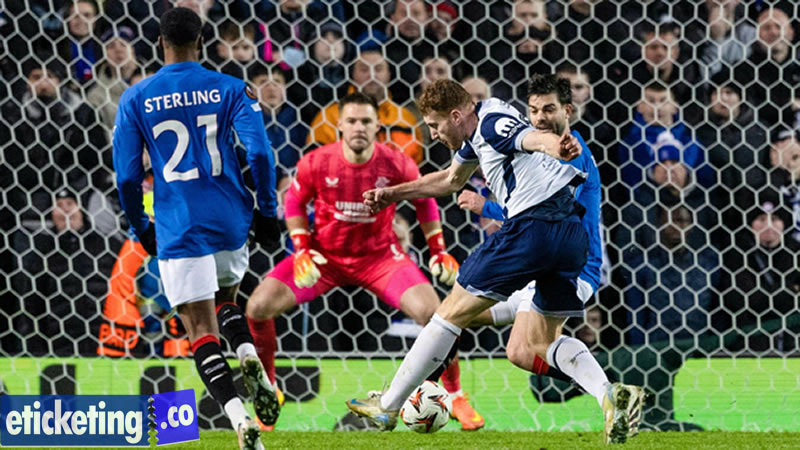Europa League Final 2026 continues to shape discussions around the tactical evolution of modern football. Particularly in how teams rely on defenders for decisive contributions. In this context, UEFA’s Game Insight Unit closely reviewed two significant goals scored by defenders during the early matchdays of the UEFA Europa League. Offering a deeper look into how backline players are increasingly influencing attacking phases.
Eticketing.co provides football fans with the opportunity to purchase Europa League Final Tickets at unbeatable prices. Fans can take advantage of exclusive discounts, ensuring they secure their seats for the biggest match of the year without breaking the bank. Explore a seamless ticket- experience and enjoy the thrill of the Last battle with us.

Their analysis highlighted the importance of defensive units stepping into advanced positions. Exploiting space, and timing their involvement to perfection. These goals also underscored the shift toward multifunctional defenders who operate with technical precision. Tactical awareness, and goal-scoring instincts once associated primarily with forwards or midfielders. By evaluating these moments, experts provided valuable insights into how defensive participation has become a key differentiator for teams seeking an edge in tightly contested European fixtures.
Defensive Evolution in Modern Football Europa League Final 2026 Tactical Lens
Modern football continues to evolve rapidly, and one of the most striking developments is the growing attacking responsibility placed on defenders. A trend that becomes even more significant when assessed through the broader context of the Europa League Final 2026. Today’s defenders are no longer expected to remain fixed in deep positions but instead participate in sequences that break opposition lines with sharp passing, purposeful forward runs, and intelligent rotation.
This shift has allowed teams to overload key zones on the pitch. Particularly when facing man-marking systems that struggle to track dynamic movement. Defenders can now time their off-ball surges with precision, stretching opponents horizontally and vertically.
Inside Runs and Full-Back Intelligence Europa League Final 2026 Context
The tactical transformation of full-backs stands out as a defining theme. Especially when viewed through patterns that often influence major European nights such as those surrounding the Europa League Final 2026. Full-backs are now required to interpret space with the awareness of midfielders while still managing their defensive duties.
By making inverted runs, they exploit interior gaps that often emerge when opponents shift laterally. These movements allow them to arrive late into dangerous zones, catching defenders off-balance. The timing of these arrivals is crucial—they enter the play just as lines of pressure are broken, ensuring they receive the ball unmarked.
Mancini’s Forward Momentum Europa League Final 2026 Tactical Echoes
The goal sequence involving Mancini highlights how defenders can dictate attacking transitions. A concept seen repeatedly in tactical approaches that shape the road toward major occasions like the Europa League Final 2026. His involvement begins with calm distribution from the back, followed by positional awareness. As he steps into midfield at the right moment.
Rather than waiting for the attack to evolve without him, he senses space ahead and moves decisively. This proactive reading allows him to surge forward just as his teammates progress play down the opposite flank. As opposition defenders scramble to adjust, a temporary numerical imbalance forms in the penalty area.
Breaking Pressure Lines Europa League Final 2026 Structural Influence
Breaking pressure lines has become one of the defining weapons for teams striving to maintain attacking control. Echoing strategic patterns often seen on the path toward major events like the Europa League Final 2026. When a defender receives the ball under pressure, the instinct used to be recycling possession backwards. Now, however, many are trained to accelerate through the first wave of opposition pressing. This ability to carry the ball with purpose forces defensive midfielders to abandon their structure and react on the move. Also Read Europa League Final Preview

Exploiting Defensive Hesitation Europa League Final 2026 Analytical Frame
Moments of hesitation inside the penalty area often decide matches, and this theme resonates strongly when examined through tactical frameworks that are commonly discussed during journeys toward the Europa League Final 2026. In Mancini’s sequence, the critical advantage arises when the opposing defender hesitates between marking two potential targets.
Such uncertainty is fatal in high-level football, where attackers rely on synchronized timing and sharp directional shifts. Mancini recognizes the hesitation and adjusts his run accordingly. Darting inside at the exact moment the defender’s body position opens a passing lane. His acceleration, paired with his awareness of space, prevents anyone from tracking him effectively.
Structured Build-Up and Controlled Transitions
In the second key example involving Aston Villa, the goal begins from a phase of controlled build-up rather than a chaotic counterattack. This reflects a growing belief in maintaining structured possession even after regaining the ball. Ensuring that the next action is purposeful rather than rushed. When Konsa collects a loose ball behind the defensive line. The immediate priority becomes establishing a stable platform from which to advance.
The pass into midfield is deliberate, enabling the team to reorganize quickly and stretch the opposition’s shape. As movement develops ahead of the ball, midfielders and attackers position themselves to create multiple passing lanes. Ensuring defenders cannot commit rigidly to one area. This well-orchestrated shift enables the next attacker to receive the ball free from pressure. Giving the team space to construct an attack that is measured, balanced. And designed to exploit the opponent’s structural weaknesses.
Timing Movements Between Opposition Lines
A key factor in successful attacking sequences is the timing of movement between defensive and midfield lines. In this scenario. The attacking midfielder arrives in the pocket with perfect coordination, receiving the ball just as opposition markers step forward. By positioning himself slightly behind their line of sight, he creates a momentary blind spot. This gives him the freedom to turn and face the goal, immediately eliminating the chasing pressure.
From this point, he has the ability to dictate the tempo of the attack, using his body orientation to invite defenders toward him. This manipulation creates a passing window toward the winger, forming a 2v1 in a highly dangerous channel. Such positioning reflects training-ground precision, where players learn to interpret body cues. Anticipate support, and recognise when defenders are caught between stepping forward or holding shape. These carefully rehearsed movements often become decisive in breaking compact structures.
Eticketing.co offers outstanding bargains on Europa League Final 2026 Tickets presenting unmatched prices for football lovers. Supporters can secure their Europa League Final tickets exclusively at special reduced rates, guaranteeing a remarkable experience at an incredible value.

Recognizing and Attacking Infield Space
The left-sided defender recognizes a key tactical opportunity when he notices an unoccupied infield zone ahead of him. This awareness allows him to initiate an attacking run timed to coincide with the pass from midfield. His decision to drive inward rather than overlap outside provides an unexpected angle. Forcing the defender assigned to that zone into a moment of confusion. Entering through the blindside of this defender ensures he arrives unnoticed.
Creating an opportunity to generate an unchallenged shot. The quick transition from midfield support to final-third involvement shows how defenders today must be versatile able to navigate tight spaces. With the confidence of midfielders while still maintaining balance behind the play. This dynamic approach generates a layered attacking pattern where late-arriving runners consistently threaten the defensive line. Increasing unpredictability and raising the overall effectiveness of the team’s offensive movements.
Constructing Attacks Through Quick, Clean Passing
An essential component of the goal’s creation lies in the crispness and tempo of the passing exchanges. When midfielders and attackers circulate the ball quickly, they compress and expand space simultaneously, forcing defenders to constantly readjust. The holding midfielder plays a pivotal role by delivering a forward pass that bypasses multiple opponents in one movement. This single action shifts the defensive structure significantly.
Eliminating several players from the play and granting the receiving attacker time to assess his options. Quick, clean passing also allows support runners to arrive exactly when needed, aligning their movement with the unfolding phases. By maintaining speed across each exchange, the attacking unit minimizes the window in which defenders can recover shape. This style of progression has become essential in modern football. Where precision and tempo determine whether a promising transition becomes a goal-scoring opportunity or fizzles out under defensive pressure.
The Importance of Scanning and Spatial Awareness
Scanning the pitch before receiving the ball has become a fundamental component of high-level football, influencing almost every successful attacking pattern. Players who consistently check their surroundings gain an immediate advantage. As they understand where pressure is coming from and which spaces are free. In this scenario, the attacking midfielder scans multiple times, allowing him to position himself perfectly between two lines. This habit enables him to receive the ball on the half-turn, eliminating defenders with a single movement.
His awareness also impacts the run of the winger, who benefits from a pass delivered with immaculate timing. Effective scanning ensures that each action flows smoothly into the next, reducing hesitation and enhancing the fluidity of the attack. When attackers and defenders alike use scanning as a routine tool, team movements become synchronized. Creating attacks that feel instinctive but are actually the product of disciplined preparation.

Eticketing.co offers football enthusiasts the perfect chance to purchase FIFA World Cup Tickets at exceptional value. Supporters can benefit from special deals and exclusive savings, making it easier than ever to reserve their place for the most anticipated tournament in global football. Experience a smooth and secure ticketing journey and be part of the ultimate football spectacle with us.
Creating Overloads in Wide Areas
Wide-area overloads play a decisive role in the final third, especially when an attacker draws multiple defenders toward the flank. In the build-up to this goal, the attacking midfielder draws pressure while releasing the winger at the perfect moment. This creates a 2v1 scenario against the full-back, who must suddenly contend with both the winger and a supporting runner. Such overloads often force defenders to make split-second decisions.
And any delay in committing allows the attacking side to control the tempo of the sequence. When executed well, these wide overloads open crossing lanes, pull centre-backs out of position. And invite late runners to arrive unmarked. Teams frequently rely on these combinations to disorganize compact structures. Using width as a way to stretch both the defensive line and midfield support. The precision of these actions determines whether the attack culminates in a clear scoring chance.
Late Runs into the Box and Their Tactical Value
Late runs into the penalty area are among the most effective methods for catching defenders unaware. When attackers delay their entry into the box, they disrupt the rhythm of defensive marking. In this scenario, the key runner holds his position outside the box long enough for defenders to focus on the immediate ball carrier. This moment of distraction creates the perfect opening for a curved run into the blindside of multiple markers.
Because defenders are drawn toward the ball, they fail to track the late-arriving threat. Once inside the box, the runner gains both the right angle and the necessary momentum to receive the final pass and finish cleanly. This type of movement requires discipline, spatial awareness, and the confidence to time the arrival perfectly. It highlights how delayed runs continue to be a powerful tool in dismantling organised defensive blocks.
Finishing from Tight Angles with Precision
Finishing from a tight angle demands a combination of technique, composure, and confidence. The final strike in this example demonstrates all three qualities. As the ball arrives, the attacker shapes his body to generate both accuracy and power with minimal backlift. Defenders typically expect a cut-back in such situations, but a direct shot surprise them and forces the goalkeeper into a disadvantageous position. Tight-angle finishes succeed when the attacker reads the goalkeeper’s positioning, identifies the gap available, and applies the correct technique to exploit it.
These goals may appear spontaneous, but they often stem from extensive practice. Where players train to strike through narrow windows under pressure. When executed in a match, such finishes can shift momentum dramatically, uplifting team morale and punishing opponents for even small lapses in concentration. Precision at these moments often reflects the attacking unit’s overall discipline and sharpness.
How Defensive Roles Continue to Shape Attacking Identity
The evolution of defensive roles continues to shape the identity of modern attacking football. Teams increasingly rely on defenders not just for stability but for initiating patterns that lead directly to goals. Whether stepping into midfield, driving past pressure, or joining attacks as late runners. Defenders now play an integral part in controlling the rhythm and unpredictability of a team’s forward movement. This multi-dimensional responsibility requires a deeper understanding of positioning, timing, and awareness than in previous eras.

As football grows more fluid, the lines between positions blur, enabling defenders to influence outcomes in ways previously reserved for attackers or creative midfielders. These modern tactical demands emphasise collective responsibility. Where every player contributes to both defensive structure and attacking invention. This holistic approach highlights how football continues to evolve into a game defined by versatility, intelligence, and constant movement across all phases.
We provide Europa League tickets for fans, offering a chance to secure Europa League Final 2026 tickets through our trusted online marketplace. Eticketing.co is dedicated to celebrating the excitement of this epic showdown and is your most reliable source for booking Europa League Final tickets.
